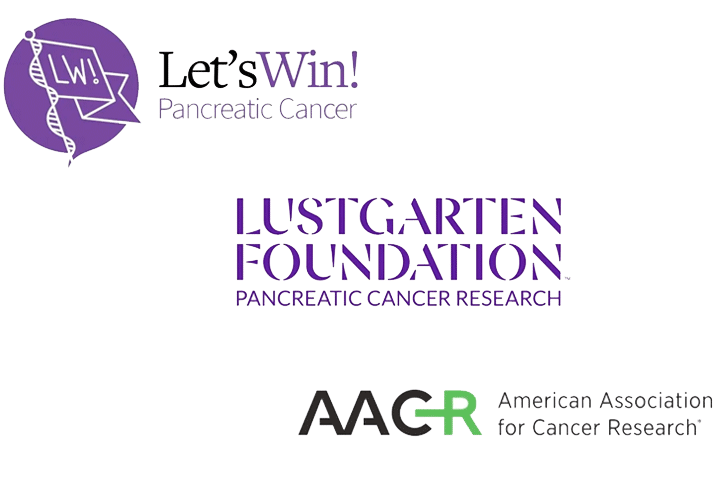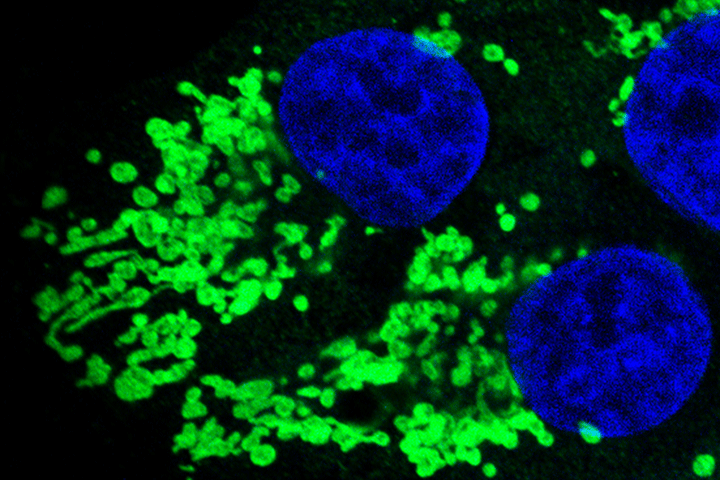The American Association for Cancer Research (AACR) Virtual Special Conference: Pancreatic Cancer Day One

The American Association for Cancer Research (AACR) Virtual Special Conference: Pancreatic Cancer proves that despite an ongoing pandemic, pancreatic cancer research hasn’t missed a beat.
Research labs across the country, and across the world for that matter, are continuing their varied and novel work in gaining a better understanding of pancreatic cancer. The goal is to translate this knowledge into new approaches to treatment that could benefit more patients. As we do every year, Let’s Win will be bringing you highlights from the two-day event held September 29 and 30, 2021. We will cover some of this research in more depth in the coming months.
This year’s conference co-chairs include Andrew M. Lowy, M.D., University of California, San Diego (La Jolla); Marina Pasca di Magliano, Ph.D., University of Michigan Medical School (Ann Arbor); Robert H. Vonderheide, M.D., D.Phil., of University of Pennsylvania Medicine, Abramson Cancer Center (Philadelphia); and Jen Jen Yeh, M.D., University of North Carolina (Chapel Hill). Lead support is provided by the Lustgarten Foundation and major support is provided by the Pancreatic Cancer Action Network (PanCAN).
Here are some highlights from Day One.
Rising Star Keynote Talk: Molecular Subtypes and Vulnerabilities in Pancreatic Cancer
The Rising Star Keynote talk was given by Andrew Aguirre, M.D., of Dana-Farber Cancer Institute, Boston, Massachusetts. In pancreatic cancer, no two tumors are alike. Aguirre reviewed data about the heterogeneity, or differences, of pancreatic cancer tumors and how a better understanding of particular features of a patient’s tumor can lead to different therapeutic options. With thousands of pancreatic cancer genomes published, researchers now know more about the drivers of pancreatic cancer and the frequency of those drivers.
For example, the majority of pancreatic cancers—more than 90 percent—have KRAS mutations. The rare tumors that do not contain KRAS mutations, so-called KRAS wild-type (WT) tumors, often have other actionable mutations, meaning doctors can target those mutations with certain therapies. For example, many KRAS WT tumors contain germline or somatic mutations in DNA repair mechanisms and are sensitive to platinum-based therapies. Researchers have also defined two major subtypes of pancreatic cancer: the “classical” type and the “basal-like.” Unlike the “basal-like” type, ongoing studies show the “classical” type of pancreatic cancer has an overall better prognosis and tends to be more sensitive to chemotherapy. But further research shows these two types are also very plastic, meaning that each type can contain cells with both features. In other words, a “classical” type can contain some “basal-like” cells and vice versa. Plus, these types can change, or transition. Research is continuing using single-cell sequencing of biopsies and organoids to better understand these subtypes and how best to treat them.
Efforts to target KRAS, the so-called “undruggable” mutation, are ongoing and showing promise. In fact, there are drugs that can inhibit the KRAS mutants common in lung and colorectal cancer, and new drugs are being generated for the mutations common in pancreatic cancer. Research in lung and colorectal cancer shows that the KRAS drugs are effective initially, but these tumors acquire resistance to treatment quickly. Scientists are working to better understand the pathways driving this resistance and running screens to better identify new targets in combination with KRAS in pancreatic cancer.
Session 1: Immunotherapy Translation In Progress
Immunotherapy has dramatically changed treatment for some cancers like melanoma and lung cancer. Researchers want to make immunotherapy a reality for pancreatic cancer too. The good news is a better understanding of the immunology of pancreatic cancer is advancing to the point where knowledge of this underlying biology is being translated into new approaches in the clinic. The following presentations highlight different approaches that may help the immune system to destroy pancreatic cancer tumors.
Dendritic cell cornerstone of tumor immunity in PDAC: Checkpoint inhibitors work by releasing a natural brake on your immune system so that immune cells called T cells recognize and attack tumors. But in pancreatic cancer, there is a lack of response to T cell checkpoint inhibitors. Researchers are trying to figure out why. According to David G. DeNardo, Ph.D. (Washington University School of Medicine, St. Louis, Missouri), the glitch isn’t caused by a lack of T cells, since these immune cells infiltrate the tumor in more than 30 percent of cases. The problem is they don’t engage with the tumor, which may be caused by a lack of antigen specificity or a lack of instruction as to how to attack the tumor. Another immune cell type, dendritic cells (DCs), may hold a clue. In other cancers, presence of DCs correlates with response to checkpoint inhibitors. DCs are impaired in pancreatic cancer animal models as well as human tumors. Researchers are investigating approaches to expand and mature DCs in animal models of pancreatic cancer. Treatment with two molecules, Flt3 ligand and CD40 ligand, has synergistic effects that lead to better outcomes in animal models. CD40 is a cell-surface member of the TNF (tumor necrosis factor) receptor superfamily and Flt3L is a cytokine that primes DC cells. Currently, a clinical trial is getting underway to test the combination of CD40 (CDX-1140) and Flt3L (CDX-301) in resectable pancreatic cancer patients.
Immunotherapy in combination: Erkut H. Borazanci, M.D. from HonorHealth/TGen (Scottsdale, Arizona) presented data from a clinical trial from the lab of Daniel D. Von Hoff of the Translational Genomics Research Institute (TGen) in Phoenix, Arizona. This phase II trial testing the combination of nivolumab (N), albumin bound paclitaxel (AP), paricalcitol (P), cisplatin (C),and gemcitabine (G)—(NAPPCG)—looked at the potential of adding a synthetic form of vitamin D (paricalcitol) to a combination of chemotherapy and a checkpoint inhibitor (nivolumab). That data, which evaluated 32 patients treated with the combination, shows promise, with the majority of the patients showing a response to the treatment. This combination is now being evaluated in a follow-up randomized clinical trial.
High quality neoantigens are immunoedited in long-term pancreatic cancer survivors: Luis A. Rojas, Ph.D., of Memorial Sloan Kettering Cancer Center, New York, discussed ongoing investigations in the lab of Vinod P. Balachandran, M.D. The lab is focused on understanding the role of neoantigens in long-term survivors. The hope is that knowledge will lead to new approaches to induce immunity that will control tumors in all patients. Analysis of long-term survivors identified the features of tumor antigens that are present and recognized in long-term survivors. Engineered antigens will be put into vaccines based on these properties. That approach is now being investigated in a trial with a neoantigen vaccine. Currently, the trial, using mRNA vaccines developed by BioNTech, is fully enrolled. Data will hopefully be available in 2022.
Session 2: Big Data
Dr. Yeh moderated the session on big data in healthcare. Big data is a term used to describe massive amounts of information created by the adoption of digital technologies. Big data approaches are being used to address a number of open questions about pancreatic cancer biology. The hope is to reveal new potential drug targets that would be hard to identify using conventional methods.
Chromatin dynamics in vivo define coordinate functions of inflammation and mutant KRAS in pancreatic tumorigenesis: Rohit Chandwani, M.D., Ph.D., Weill Cornell Medicine, New York, spoke about the development of a mouse model with mutant KRAS that was treated with cerulein to induce pancreatitis (inflammation). This allowed the researchers to look at the early changes in the pancreatic acinar cells as they transition towards pancreatic cancer. The good news is they are seeing signals in specific pathways that may be drivers of this transition.
Integrative genomic characterization of therapeutic targets for pancreatic cancer: Jimmy A. Guo, an M.D./Ph.D. candidate at Broad Institute of MIT and Harvard, (Cambridge, Massachusetts) is currently working at the Broad Institute/Aguirre lab. He spoke about the integration of large ‘omic data sets to help identify new potential drug targets. The team has identified a number of potential targets, including some on the cell surface that are clinically validated as well as some novel targets. Ongoing research is now hoping to validate potential targets by looking at heterogeneity of expression and whether these targets change expression with chemotherapeutic treatment.
Lung-tropic, liver-averse, primary PDAC tumors are associated with greater peripheral T cell diversity and have a unique, subtype-independent, gene-expression signature that significantly correlates with longer survival: Jason M. Link, Ph.D., Oregon Health & Science University, Portland, Oregon reported on the ongoing research in the lab of Rosalie C. Sears, Ph.D., that focuses on patients with lung metastases. These patients survive longer than those with liver metastases. The lung cohort has more of a “classical” subtype of pancreatic cancer, but this does not entirely explain survival benefit. The team hopes to define gene expression that drives organ tropism and better survival. Three key features are emerging: low replication stress (pORG), low EMT (pSUB), and high peripheral TCR diversity. Efforts are underway to find ways to target these features therapeutically.
Read the highlights from Day Two to learn more about the latest research.






